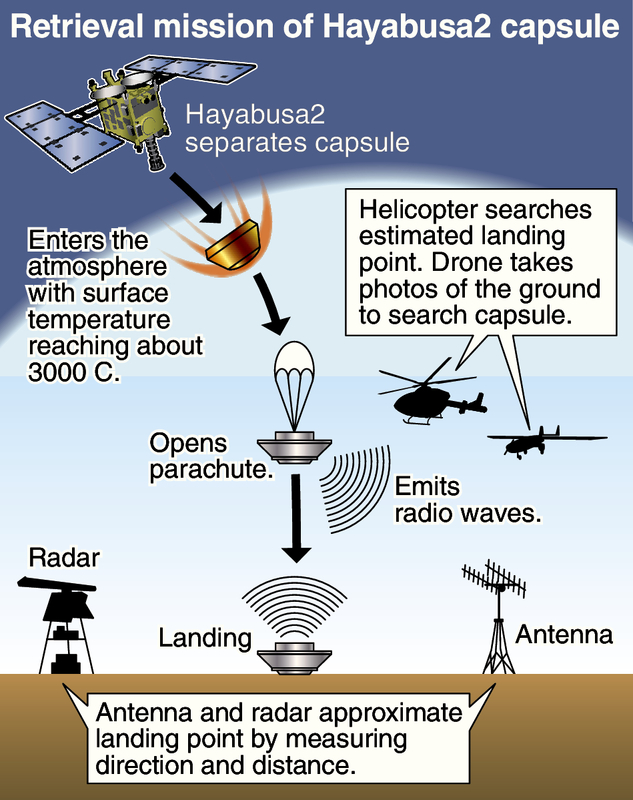
Space explorer Hayabusa2 is set to return to Earth in early December.
The capsule, believed to contain samples of sand and stone from the asteroid Ryugu that is located about 220,000 kilometers from Earth, is scheduled to separate from a probe on Saturday and touch down in the Australian desert the following day.
Will this box of treasures be able to withstand the extreme heat during reentry into the atmosphere and be successfully retrieved? The mission will be the highlight of a six-year odyssey.
The capsule will detached from the probe and reenter the atmosphere from outer space at an unimaginable speed of about 12 kilometers per second -- 10 times faster than a bullet shot from a rifle -- with its surface temperature reaching about 3000 C.
If it burns out, all the efforts made on behalf of the mission will have been done in vain.
IHI Aerospace Co., a Tokyo-based manufacturer of mainly rockets, developed what is called a heat shield to protect the capsule from extreme heat.
The heat shield is made with special resin that melts at high temperatures and turns into gas that covers the capsule. This gas keeps the temperature inside the capsule at 50 C or below.
"We tested the heat shield several hundreds of times for heat resistance and strength. I'm sure the capsule will make it back for us," said a confident Fumitaka Sugimura, 53, who works in the company's base technology department.
After clearing the hurdle of atmospheric entry, the capsule's parachute should open as it slowly descends to the desert. The antenna and radar on the ground should pick up the radio waves the capsule emits. A helicopter will then head for the landing point, which is approximated from the radio waves, to retrieve the capsule.
If the capsule is unable to transmit these radio waves, a drone will be used to search for the capsule from photographs it takes. This method was not employed during the first Hayabusa mission.
The drone set up for Saturday's mission is a 3-meter-long and 5-meter-wide model that resembles an airplane. The Yokohama-based drone manufacturer Fuji Imvac Inc. modified the engine for the upcoming retrieval mission.
"We've been so driven by the passion to unravel the mysteries of the universe," Fuji Imvac President Seiji Tanabe said, describing how all the employees responded to the mission team's efforts.
It is summer in Australia, where the temperatures might exceed 40 C in December. Despite the heat, members of the retrieval team will have to suit up in protective wear because of the possibility that gunpowder remaining in the capsule could ignite.
"We've finally made it to this point. It is our desire to use a total team effort to bring the capsule back to Japan," said Satoru Nakazawa, 51, a deputy manager who leads the 73-member retrieval team from the Japan Aerospace Exploration Agency.
After the capsule separates, the probe is scheduled to alter its orbit and continue on a mission to another asteroid.
Read more from The Japan News at https://japannews.yomiuri.co.jp/







